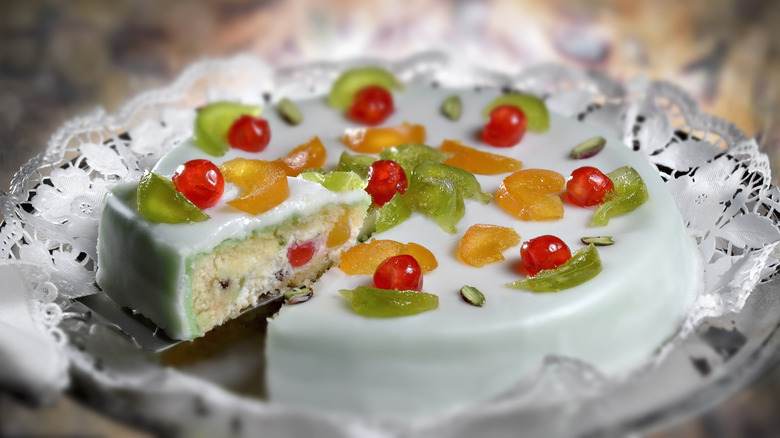The Debated History Of Cassata Cake
Everyone knows about the most basic cakes; vanilla, chocolate, red velvet, and carrot, but there is a whole world out there with strange and wonderful cakes that have been around for centuries! Treats like the pound cake, Asian Fruit Cream cake, Gâteau Basque Cake, Tres Leches Cake, Honey cake, or classic Opera cake are all delicious — and definitely not basic — recipes that can make any dessert-lover swoon, but one of our favorites just so happens to be the cassata.
The cassata cake is not your average tiered-sponge recipe. Instead, Allrecipes describes this masterpiece of a layered cake like a gooey Sicilian cannoli made with whipped egg whites and folded into a light, fluffy batter. This mix is then flavored with rum syrup, glazed with chocolate, and filled with cinnamon-flavored ricotta cheese. Today, cassata cake is thoroughly enjoyed by Italians and people around the globe, but its origins are a hot topic of debate. Unfortunately, as with many historical recipes, documentation of the cassata's invention has been lost to time, but a few theories do exist.
Prevailing theories
Every great recipe comes with a legend. The Florentine cookie is believed to have been inspired by Italian gold coins, Indian pudding is the American evolution of hasty pudding, and the legend of the Anadama bread tells of an angry fisherman and his wife. As for the origin of the cassata cake, we have to trace it back to the 10th century. Eater claims that this ricotta-filled cake was born in Sicily and is traditionally decorated with marzipan and candied fruits.
The historians Eater consulted state that, in the 10th century, invaders to Sicily merged their knowledge of sugar production with Italian pastry skills to create the cassata cake. But not everyone agrees with this theory. Some believe that the name "cassata" simply comes from the Italian root word for cheese and that there is no definitive proof that the cake's invention has anything to do with the invasion of Sicily.
That being said, Taste Atlas says that while the cassata might have derived from the Arabic word qas'ah, it is still widely deemed a Sicilian specialty. The cassata cake was prevalent among the wealthy European aristocracy by the 14th century and remained a popular dessert to serve during the Easter holiday. Regardless of its origin, everyone can enjoy the cassata cake and all its variations today, and isn't that the most important bit of this dessert's story? Despite the years, it still lives on in people's hearts and bellies.

